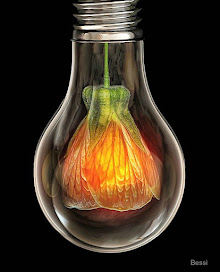 Nicolas Mazard, manager for micro-greens specialist Koppert Cress USA, is part ringmaster and part pusher. Dressed in company regalia he takes center stage at the Koppert Cress booth and presents an intriguing selection of microgreens to curious passersby at the 2008 International Chefs Congress. His melodious French accent and striking good looks are as riveting as the selection of micro-greens he presents; each intensely flavored and complex. The star of the show is not the Tahoon Cress (which tastes like the aroma of a beech tree forest after a good spell of rain) or the Purple Shiso (which tastes like fresh cumin and violets) or the Borage Cress (which tastes like the delicate brine of oysters and freshly cut cucumbers); it is a tiny flower head that Koppert calls the “Sechuan Button”.
Nicolas Mazard, manager for micro-greens specialist Koppert Cress USA, is part ringmaster and part pusher. Dressed in company regalia he takes center stage at the Koppert Cress booth and presents an intriguing selection of microgreens to curious passersby at the 2008 International Chefs Congress. His melodious French accent and striking good looks are as riveting as the selection of micro-greens he presents; each intensely flavored and complex. The star of the show is not the Tahoon Cress (which tastes like the aroma of a beech tree forest after a good spell of rain) or the Purple Shiso (which tastes like fresh cumin and violets) or the Borage Cress (which tastes like the delicate brine of oysters and freshly cut cucumbers); it is a tiny flower head that Koppert calls the “Sechuan Button”. Sechuan Button is a term coined by Koppert Cress for Acmella oleracea, a plant developed through cultivation of Acmella alba, which is native to Peru and Brazil. The flavor of the flower head possesses a kick that resembles the spiciness of a Szechuan pepper, hence the name used to market it. Acmella oleracea became naturalized in East Africa and now grows throughout the continent. Its leaves are traditionally added to salads, soups and meat dishes, but the flower heads are more commonly used for toothache, throat and gum infections.
The flower heads produce a unique sensation that is the umami of mouthfeel, creating a kinetic feeling on the side of the mouth where it’s chewed.
 Anesthetic effects of numbness and tingling accompany another sensory experience, which is unsettling to the novice Sechuan Button eater; watering of the mouth. When the puckish Mazard initiates the tasting of Sechuan Buttons, he carefully dispenses a quarter of a bud to each person, enthusiastically awaiting the response of audience members as they traverse a course that begins with fear and evolves into fits of giggling and laughter. “Remember what it felt like when you were a kid and licked a 9-volt battery?” Mazard asks, “That is the feeling you experience with Sechuan Buttons. It’s like having electricity in your mouth.”
Anesthetic effects of numbness and tingling accompany another sensory experience, which is unsettling to the novice Sechuan Button eater; watering of the mouth. When the puckish Mazard initiates the tasting of Sechuan Buttons, he carefully dispenses a quarter of a bud to each person, enthusiastically awaiting the response of audience members as they traverse a course that begins with fear and evolves into fits of giggling and laughter. “Remember what it felt like when you were a kid and licked a 9-volt battery?” Mazard asks, “That is the feeling you experience with Sechuan Buttons. It’s like having electricity in your mouth.”
 Anesthetic effects of numbness and tingling accompany another sensory experience, which is unsettling to the novice Sechuan Button eater; watering of the mouth. When the puckish Mazard initiates the tasting of Sechuan Buttons, he carefully dispenses a quarter of a bud to each person, enthusiastically awaiting the response of audience members as they traverse a course that begins with fear and evolves into fits of giggling and laughter. “Remember what it felt like when you were a kid and licked a 9-volt battery?” Mazard asks, “That is the feeling you experience with Sechuan Buttons. It’s like having electricity in your mouth.”
Anesthetic effects of numbness and tingling accompany another sensory experience, which is unsettling to the novice Sechuan Button eater; watering of the mouth. When the puckish Mazard initiates the tasting of Sechuan Buttons, he carefully dispenses a quarter of a bud to each person, enthusiastically awaiting the response of audience members as they traverse a course that begins with fear and evolves into fits of giggling and laughter. “Remember what it felt like when you were a kid and licked a 9-volt battery?” Mazard asks, “That is the feeling you experience with Sechuan Buttons. It’s like having electricity in your mouth.” Koppert Cress suggests using Sechuan Buttons in sorbets and mixed drinks, but its application in flavors is limitless, provided that proper contrasts and pairings are achieved.
Indulging in “buds”? That’s a bit Cheech and Chong. Chewing “buttons”? Sounds like an allusion to Aldous Huxley’s adventures with mescaline in The Doors of Perception. The marketing of Sechuan Buttons brandishes an element of the narcotic with the culinary, as well it should; the active ingredient in Acmella oleracea which produces unique sensations in the mouth is the molecule spilanthol (N-isobutyl-4, 6-decadienamide). Spilanthol is an antiseptic alkaloid that is a poison for most invertebrates, but harmless to warm-blooded animals. The molecule acts on the trigeminal nerve, which affects sensations in the face.
My personal experience with the effects of Sechuan Buttons is a mild euphoria, which transpires after eating a single flower head over the course of an hour, one quarter of a bud at a time. Appetite makes the mouth water and Sechuan Buttons definitely trip a switch in the brain that triggers feelings of pleasure when you understand all of the plant’s sensory effects and aren’t frightened by them.
There are six distinct qualities that are experienced when tasting Sechuan Buttons. As one chews the flower head, the senses course through green, bitter, numbing, electrical, tart, and lemon sensations.
According to Plant Resources of Tropical Africa (also know as PROTA), essential oil distilled from the fresh flowers contains high amounts of the dietary cannabinoid β-caryophyllene (its flavor resembles black pepper, hence the appropriate marketing nomenclature on Koppert Cress’ part). Other major constituents include limonene (lemony), thymol (thyme-like), cadinene (green-like) and germacrene (spicy and woody). When one understands the sensory qualities of Acmella oleracea's molecules (referenced by flavor chemists as “organoleptic properties”) the science of taste becomes more fascinating as it is a yardstick with which one can measure sensory experiences.
Sechuan Buttons have given the term “nipping it in the bud” a whole new meaning. Perhaps Koppert Cress USA should consider the California Milk Processor Board’s marketing of milk when promoting the exotic and zingy treat: "Got electricity?"
Notes:
Horizon Herbs sells three varieties of organic Spilanthes seeds (another species term for Acmella oleracea) that can be sown in the spring if you wish to grow your own flower heads.
The plant also goes by the French name Brede Mafane or paracress.
Micro-greens are a plant's first true leaves and are not to be confused with sprouts. Chefs use them as flavorful garnishes as their size belies the intensity of their flavor.
The Koppert Cress micro-green selection is beautifully presented here. An equally compelling document on the Sechuan Button is available on the company’s site. Product photos and picture of Nicolas Mazard are from the Koppert Cress website.





